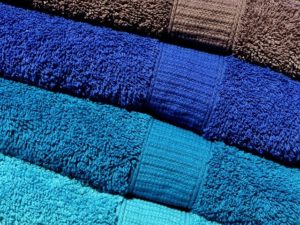Dye and pigment (food, clothing, consumer goods)
BACKGROUND:
Indigodine is a natural blue pigment that retains its brightness and has direct uses in the dye and pigment industry. Notably, it shows promise as an alternative to synthetic dyes and in providing health benefits as an antioxidant and antimicrobial actor.
Previous patents from LBNL include promising fungal systems for high yield production and high scales for this compound. This technology provides a systematically engineered microbial strain, notably with predictably reliable performance across scales with high conversion from renewable carbon. This invention uses a well-understood, and industrially used GRAS bacterial platform, Pseudomonas putida. Production at the 2L scale has been demonstrated in this host at a productivity of 25g/L in minimal salt media from glucose. Production of indigoidine from this host can also be completed in economically sourced minimal salt media, without the need for costly peptone or typone yeast extracts. P. putida, provides an additional benefit of being easily lysed with detergents with potential to provide advantages to downstream separation.
TECHNOLOGY OVERVIEW:
Researchers at Berkeley Lab have genomically integrated a bioproduction pathway in Pseudomonas putida KT2440 and optimized cultivation conditions to maximize the production of indigoidine. Production of the molecule to 12 g/L can be realized in the absence of antibiotics. Adding antibiotics allows the use of newly developed CRISPR systems which can boost production up to the 25 g/L.
The invention involves a metabolic modeling approach that predicted that the deletion of a set of genes would lock growth to indigoidine (or glutamine) production. Researchers used an inducible, endonuclease-dead CRISPR based strategy to simultaneously target genes for repression. As predicted by the model – the engineered P. putida KT2440 strain had massive improvement of indigoidine production rate, yield, titer, and reproducibility. It is capable of producing indigoidine using 1% (56 mM) glucose of up to about 3.5 g/L, which is about 45 % of the theoretical max yield from this carbon source. In a 2L fed-batch production campaign, the growth-coupled strain produces about 25 g/L indigoidine from 60 g/L glucose, which is 41 % theoretical max yield. In fact, the present technology achieves the highest known yield of this compound from glucose as a sole carbon source.
BENEFITS:
- The engineered strain and the metabolic modeling approach taken maximizes indigoidine production towards its theoretical max and enables faster production rates in a reliable manner across scales.
- This technology uses a well-understood, and industrially used GRAS bacterial platform, Pseudomonas putida.
- Production can be completed in economically sourced minimal salt media.
- P. putida is easily lysed with detergents.
DEVELOPMENT STAGE: Proven principle
PRINCIPAL INVESTIGATORS:
STATUS: Patent pending.
OPPORTUNITY: Available for licensing or collaborative research.
SEE THESE OTHER BERKELEY LAB TECHNOLOGIES IN THIS FIELD:
High Titer Production of Indigoidine in Rhodosporidium toruloides 2018-129
Blue Pigment from Engineered Fungi Could Help Turn the Textile Industry Green
